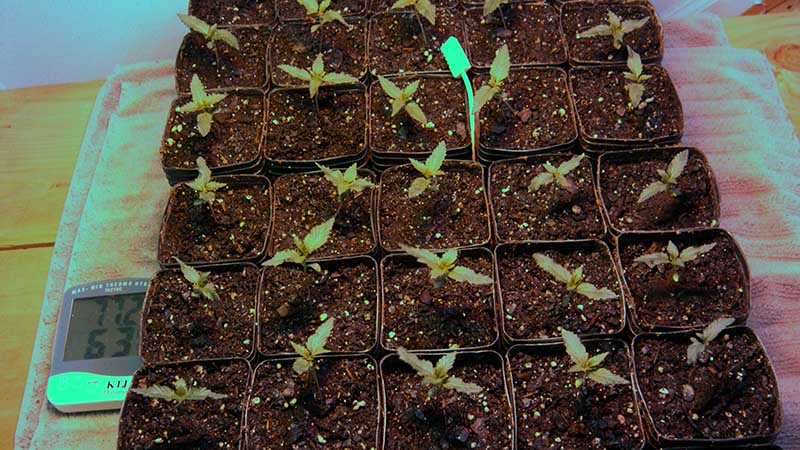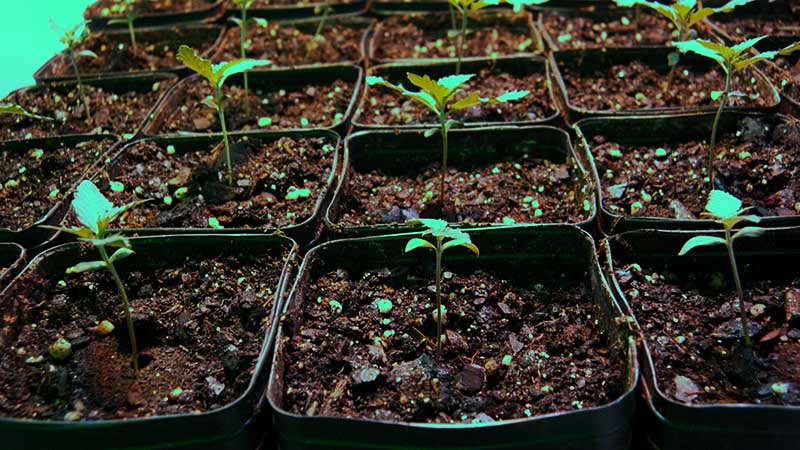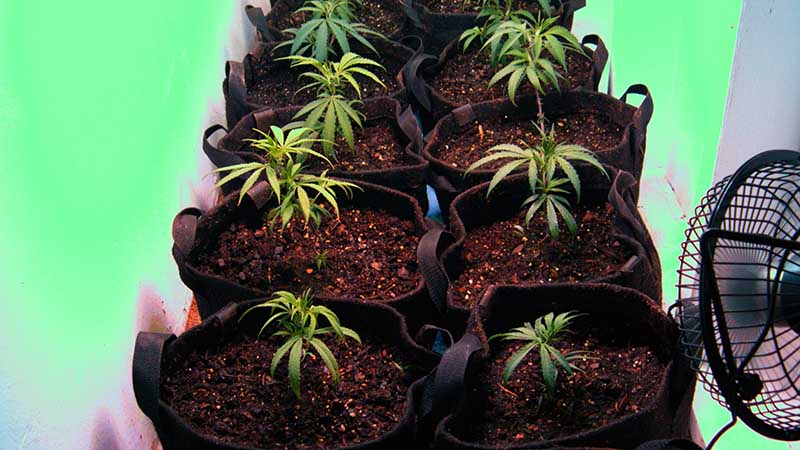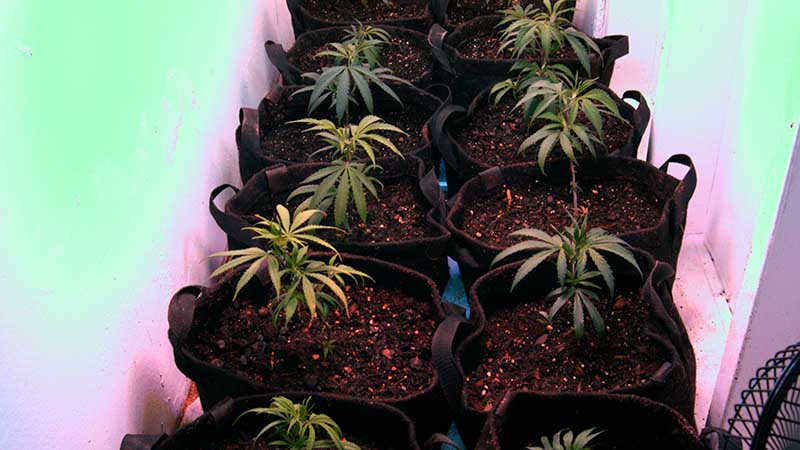Even though the weather still indicates summer, it's time to plan for the Christmas harvest. I've got 40 seedlings developing in the clone closet along with 16 clones in the veg closet. This is the third and final batch of clones from the original plant I chose and because it hasn't stabilized into the pheno I desired, I'm terminating this project. The only significant trait remaining from the original plant is a resistance to bud rot and that won't be an issue with a December harvest in the basement. The plants lost a lot of the inherent vigor of SouthEast Lights in both root and leaf development. They just weren't anything special like the original plant, in spite of my attempts to duplicate the environment it was developed in. The high summer humidity is likely the root cause and it will be interesting to see if I'll be able to alleviate that problem next summer, even with a dehumidifier. I'm not sure how effective running one during the dark phase of flowering with the exhaust fan turned off is going to be.
Seedlings and Clones For Christmas
I don't believe I've ever kept a set of clones past 5 grows and the thought of keeping a "mother" plant alive for years and years on end seems like abuse. Cannabis plants are labeled as annuals for a reason and just because you can alter their environment to keep them in a perpetual state of vegging, doesn't mean you should. Every time I read about a cannabis "breeder" keeping a mother plant alive for decades, I wonder what the fuck they are thinking. Their original plant is going to change and evolve over the years and will not be the same plant they started out with years ago. They're trying hard to recreate what has already been created, in a futile effort to duplicate what has happened in the past. That's not how things operate in the Time Space Continuum here on earth. The secret to developing cannabis was given to me a long time ago in Frank and Rosenthal's Growers Guide:
The ultimate quality of a cannabis plant is the end result of the genetic material contained in its DNA combined with the environment it was developed in.
Don't You Feel Small?
We've been having some really cool and crisp weather for mid-August here in the mountains, perfect weather for consuming some SouthEast Lights canna-cookies and observing the planets, stars and constellations in the late summer night sky. It always makes me think just how small and insignificant we are in the Universal scheme of things. Carl Sagan's Cosmos series on PBS and Stephen Hawkins book A Brief History of Time initiated my interest in cosmology and forever changed the way I view life here on earth, and in other galaxies as well. When you realize the light you are viewing from visible stars here on earth was created thousands of years ago, it becomes almost impossible to comprehend. Now expand that vision out to the billions of galaxies contained in the universe and realize the light from those galaxies is billions of years old. Carl Sagan frequently used the term "billions and billions" for a very good reason.
I've had a lifelong aversion to all things mathematical, that's just not how my mind is structured. When the exceedingly large numbers necessary to demonstrate the vast distances between objects in space are used, the numbers become almost meaningless. To illustrate the distances involved much more effectively than I ever could, watch the videos below that show in great detail just how small and insignificant our entire Milky Way galaxy is.
There is so much we will never, ever know about our universe.
The Known Universe
Observable Universe
The concept of a lightyear is truly remarkable and almost impossible to comprehend, uniting time and immense distance into a mathematical formula. Even if humans on earth could somehow travel at the speed of light, the closest known galaxy to our Milky Way is the Canis Major Dwarf Galaxy, a mere 25,000 light years away. Oh, and did I mention there are an estimated 100 billion galaxies in the universe? These are almost impossible concepts to comprehend, much less contemplate. You also have to remember we are viewing the universe through the smeared and murky lens of our atmosphere, so imagine the objects we are not able to even perceive. Liberated from Earth's obscuring atmosphere, the Hubble telescope revealed a view of the universe never observed before.
Hubble Deep Field
YouTube Video by "In Memory of jt"
When pointed at an unbelievably narrow section of space that appeared completely empty, the Hubble Ultra Deep Field view revealed over 10,000 galaxies. The definition of a galaxy is a gravitationally bound system of stars, stellar remnants, interstellar gas, dust, etc. and galaxies range in size from dwarfs with just a few hundred million stars to massive giants with over one hundred trillion stars. Remember, this was a supposedly blank spot of space and yet it contained more solar systems than the rational mind can comprehend. In addition, light the Hubble telescope acquired was over 8, here comes Carl's favorite word, billion years old. I wonder what's happening there now, in our current space-time reality, or do those galaxies even still exist? While distance can be accurately measured, time is much more ethereal. Time is a concept I'll have to write about at some point in the future because I have experience with how it's altered and is perceived in an infinite number of ways.
Thinking is the best way to travel.
Nikon 4300 Functional Again!
I've finally got the Nikon 4300 functional again after many months of frustration. I'm sure no one understands why I don't just trash the old relic and start using our first edition Digital Rebel, as it has no GPS capability either. Security issues aside, in addition to the legendary Nikon lens quality, the reason I still want to use the 4300 is it always releases the shutter when I push the button. Except in full Manual mode, if the Rebel thinks there will be any image blur, it won't let you take the photo. For me, that is simply unacceptable. Even with the minuscule 4 megapixels, the photos here are quite sharp, even at larger screen resolutions. I've always tried to show the kids that sometimes you can do more with less, so they'll understand why I still use the 4300.
The first grow of 2018 was problematic from the time I transplanted them into the initial fabric pots all the way through harvest. March here in the mountains is still quite cold and when the plants made the transition from the warm upstairs environment in the veg closet down to the cool basement tent, they went into suspended animation for about a month. When growth began again, I forgot I was using fresh, un-flushed potting soil and fucked up when I used the normal amount of Peter's 20-20-20 I use during the mid-vegetative stage. This resulted in a fertilizer OD that was clearly evident by the dark green, hanging, claw like leaves. The plants had not been able to utilize the fertilizer I gave them during the initial transplant into fabric pots because of the cool basement temps and then I douched 'em again with more fertilizer. Even experienced cultivators fuck up sometimes, I'm one of the rare ones who admit it.
The OD of fertilizer resulted in an overwhelming mass of leaves and the development of the first/worst case of bud rot I've ever had. It's caused by the fungus botrytis cinerea and as good as that may be for the wine grapes used in a Sauternes, it will decimate a cannabis crop quickly. For cannabis, it most assuredly is not a "noble rot". While I've experienced mild cases outdoors due to cloudy and rainy Septembers, it had never affected the plants this bad. I lost the main colas on all but 3 plants. Next year I will invest in a de-humidifier which should help tremendously.
Now on to the second grow of 2018. I wish I had pictures from the first grow for comparison purposes, so you could compare and contrast the leaves. Notice in the first photo how the leaves seem to be reaching towards the light? I call that the joy of life and it's indicative of a plant that is in perfect balance and is getting everything it needs. The leaves are at more than a 45 degree angle in relation to the stem and appear to be reaching for the light. The next photo shows how leaves should look when they're getting the correct amount of fertilizer. Notice how the tips of the leaves aren't brown? That is usually the first sign of over-fertilization, rapidly followed by the tips of the leaf serrations turning brown as well. The last photo demonstrates how close I keep the LED lights, usually between 8-12 inches. Even with the high PAR output of these lights in such close proximity, I've yet to have any bleaching of the leaves. SouthEast Lights has been exposed to extreme HID lighting for almost 20 years now so I think its chlorophyll is immune to bleaching.



